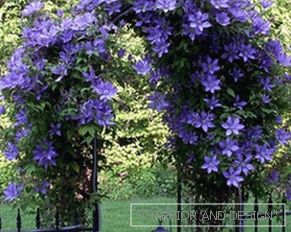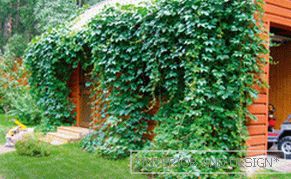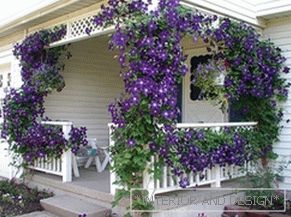 On the garden plot can grow completely different plants, ranging from lawn grass and ending with fruit trees. Far from last place are climbing plants. They are a wonderful decoration for the garden, and also help to hide the defects of buildings. Types of climbing vines very much. They differ in the shape and color of leaves, growth rate, life expectancy. Among these plants there are many flowering plants. Even the most demanding gardener will be able to find something to his liking.
On the garden plot can grow completely different plants, ranging from lawn grass and ending with fruit trees. Far from last place are climbing plants. They are a wonderful decoration for the garden, and also help to hide the defects of buildings. Types of climbing vines very much. They differ in the shape and color of leaves, growth rate, life expectancy. Among these plants there are many flowering plants. Even the most demanding gardener will be able to find something to his liking.
Content
- 1 Popular varieties of climbing plants for the garden
- 2 How to choose
- 3 Where to place
- 4 How to care for climbing plants for the garden
Popular varieties of climbing plants for the garden
- Girlish or virgin grapes. This is a fairly unpretentious plant with emerald green leaves. In the fall, the foliage becomes a beautiful purple color and dark blue grapes appear on the plant.
- Ivy grows well in the sun and in the shade. Able to withstand low temperatures and even resistant to small frosts. It grows rather slowly, but the gazebos covered with its leathery leaves and the facades of the houses look great.
- Clematis blooms in early spring or in the middle, depending on the variety. If you plant several varieties of this plant, you can enjoy flowering all spring. Planting clematis is better so that the leaves are in the sun, and the stem and soil at the root remain in the shade. On winter plant need to cover.
- The Pink Rose very beautiful at the time of flowering, but requires some care. The first 3 years of her need to cover for winter. It will be possible to see the flowering of a climbing rose only in the second year. Clean dry shoots need to be carefully, because the buds appear on last year's shoots. Climbing rose must be cut so that it does not grow strongly and does not look neglected.
- Sweet pea blooms from July to the first frost. Plant height can reach 3 m, and the color of flowers is varied.
- Morning glory very unpretentious. It can be safely planted in the shade. Begins to bloom in June and blooms until late autumn.
- Nasturtium is a climbing plant, although it is preferred to be grown in a creeping form. This is due to the fact that she has fragile, easily breaking shoots.
- Kobeya blooms with large blue or white flowers from July to October. It grows up to 5 m tall. Very naughty plant, requires a lot of sun and timely watering.
- Tunbergiya quite unpretentious, although he loves sunshine. Watering should be moderate. The plant blooms from July to late September.
- Honeysuckle undemanding to care. In the dry summer, it is enough to water 1-2 times. It must be cut, otherwise the plant will turn into a tangled ball.
How to choose
 At choosing Climbing plants should take into account some points.
At choosing Climbing plants should take into account some points.
- Growing conditions. Heat-loving plants will grow poorly in places with a cold climate. There are plants that need abundant watering, or vice versa, very moderate. Some require additional care in the form of pruning shoots or tying. Inexperienced gardeners are best to choose the most unpretentious plants.
- Lifespan. Perennials do not need to be planted every year, but they eventually thicken and woody shoots. Annuals look sleeker, but require an annual disembarkation.
- Mounting method:
- Curly Vines. In a natural environment wrap around plants. In the garden for them you can stretch the rope, wire, slats will fit, you can build the whole structure of these materials.
- Climbing. They do not require additional support, they curl well over a rough surface. Differ unpretentious, high rate of growth.
- Clinging. With the help of shoots cling to the surface. They will need a support made of rope or wire.
- Leaning. These plants need to be tied up so that they do not fall, because they are not able to cling to the surface.
Where to place
 Often climbing plants post in those parts of the garden where it is necessary to hide unsightly places, any defects. Such places can be the walls of a house, outbuildings, a fence.
Often climbing plants post in those parts of the garden where it is necessary to hide unsightly places, any defects. Such places can be the walls of a house, outbuildings, a fence.
In addition to camouflage, climbers can appear as natural jewelry. The arbor or pergola entwined with garden vines looks impressive. On a hot summer day you can find coolness in such a building, and on an overcast day - protection from rain. Decorated with climbing plants arch or trellis will be a real work of art in the garden.
Low vines make out flower beds, ridges, low fences and barriers. With the help of green fences, tapestries, it is easy to divide the site into several zones.
Council Climbing plants отлично подходят для создания живой изгороди. Наибольшее распространение в этом качестве получили низкорастущие кустарники, которые высаживают близко друг к другу и поддерживают выбранную форму ограждения путем периодической обрезки. Однако еще более чудесным образом выглядит живая изгородь, усыпанная цветами, например, плетистой розы. Дополнительное преимущество заключается и в том, что на небольшом участке сложно найти место для полноценного розария, а размещение роз на шпалерах является одновременно и практичным приемом, и изысканным решением оформления забора. Для создания живой изгороди можно использовать не только плетистые, но и кустарниковые розы, которые прекрасно взберутся по вертикальным подвесам. Следует учитывать, что как бы ни была хороша роза, но даже бриллиант становится особенно эффектным лишь в надлежащей оправе. Для подчеркивания красоты королевы цветов нужно подобрать правильных спутников, в таком качестве отлично подойдет клематис, который даже не обязательно включать в состав самой живой изгороди, достаточно разместить его на supportх. Отличным фоном станут манжетка мягкая или котовник Фассена. Для создания контраста можно использовать жимолость, которую высаживают по углам изгороди.
For example, you can select a dining area or a place to rest. Particularly impressive is the path to the house, which goes through a series of arches entwined with climbing plants.
For most lianas required support. It is necessary to expect that an adult plant with abundant foliage, reaching a height of several meters, has significant weight. Therefore, climbing and clinging vines are better tied up so that they do not collapse under their own weight.
It is necessary to take into account the "windage" of climbing plants when they decorate a gazebo or pergolas. Buildings should be good secured in place. Otherwise, strong gusts of wind can move or overturn them.
How to care for climbing plants for the garden
-
 As long as the planted plant takes root, it must be often water. The soil should be hydrated, but excessive moisture can lead to the death of creepers. The plant will either wither or its roots may rot.
As long as the planted plant takes root, it must be often water. The soil should be hydrated, but excessive moisture can lead to the death of creepers. The plant will either wither or its roots may rot. - Young, newly planted shoots need guide. To do this, they can tie up or tighten additional ropes.
- Curly vines require timely trimming. This is due to the fact that many of them grow quickly enough, seize the nearby territory and the bushes and trees on it. If climbing plants decorate a house, they should not go up the drain, telephone line, energy channels. With a lot of weight, they can tear them off, and the fallen leaves in the fall will clog up the drain. Roof also should not be covered with plants. Their branches in the winter delay the snow, in addition, they can crawl under the tiles and undermine it.
- Must be avoided inappropriate for landing places. Climbing plants can not be planted next to buildings that are dilapidated or have defects, cracks. Climbing vines can grow roots into cracks and gradually destroy the walls. If the walls of the house freeze over in winter, then near them also should not be planted climbing vines. Their branches will block the walls from the sun and will not allow them to dry out in the summer.
- The roots of the plant should be plenty of room для роста и развития. Высаживать вьющиеся растения нужно на расстоянии от 50 см до 70 см от стены дома. В этом случае у лианы будет plenty of room и питания для роста и развития.
With the help of climbing plants the garden plot can be made special, непохожим на другие. Curly Vines являются своеобразной изюминкой в ландшафтном дизайне. At правильном уходе эти растения способны превратить обычный садовый участок в уголок романтики и очарования.



